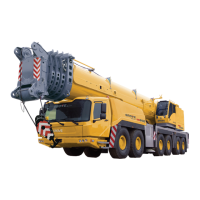OPERATING CONTROLS AND PROCEDURES RT765E-2 OPERATOR MANUAL
3-36 Published 4-09-2021, Control # 364-11
The Load Charts are divided into structural strength and
stability limits. This is shown by the bold line across the chart.
Capacities above the line are structural strength limits and
capacities below the line are stability limits.
The left column is the load radius, which is the distance from
the center of crane rotation to the load center of gravity. The
top row lists various boom lengths ranging from fully
retracted to fully extended or boom extension lengths and
offsets. The number at the intersection of the left column and
top row is the total load capacity for that load radius and
boom length or boom extension lengths offset. The number
in parentheses below the total load capacity is the required
boom angle (in degrees) for that load. When the boom length
or lift radius or both are between values listed, the smallest
load shown at either the next larger radius or next longer or
shorter boom length shall be used.
Another important section is the range diagram. The range
diagram shows the operating radius and tip height that can
be achieved at a given boom length and angle. If the
operator knows the radius and tip height required for a
specific lift, the angle and boom length can be quickly
determined from the range diagram. Or, if the boom length
and angle are known, the tip height and operating radius can
be quickly determined.
A lifting diagram is included to describe over side, over rear,
and over front lifting areas. The lifting area diagram shows
that the locations of the outrigger jack cylinders in the fully
extended position are used to mark the boundaries of the
lifting areas.
A boom extension capacity chart and notes are included to
list the capacities for the extension length, load radius, and
boom angle.
Another section contains the notes for lifting capacities. Be
sure to read and understand all the notes concerning lifting
capacities.
The load chart also gives weight reductions for load handling
devices such as hook blocks, overhaul balls, boom
extensions, etc., which must be taken into consideration as
part of the load. Remember, the weight of any other load
handling devices such as chains, slings, or spreader bars
must be added to the weight of the load.
Proper Leveling of the Crane
ASME B30.5 specifies that if a crane is not level within 1% of
grade, the allowable capacities must be reduced. Therefore,
whether lifting on rubber or outriggers, it is essential that the
crane is level to within 1% of grade. The bubble level that is
provided on the crane is calibrated to be accurate within 1%
of grade.
To properly level the crane, the boom must be positioned
over the front of the crane, fully lowered to horizontal and
fully retracted (for cranes fitted with a boom rest, the boom
shall be stowed onto the rest). Raise and level the crane
using the outriggers; refer to Setting the Outriggers, page 3-
37.
A working crane may settle during lifting operations.
Frequently check the crane for level. When rechecking the
crane for level, the boom must be positioned over the front of
the crane, fully lowered to horizontal and fully retracted (for
cranes fitted with a boom rest, the boom shall be stowed
onto the rest). If necessary, relevel the crane using the
procedures under Setting the Outriggers, page 3-37.
Bubble Level Adjustment
The bubble level adjustment should be checked periodically;
if it is suspected that the bubble level indicator is out of
adjustment, verify and adjust the bubble level as follows:
1. Locate the crane on a firm, level surface.
2. Extend and set the outriggers. Level the crane, as
indicated by the bubble level indicator, using the
outriggers.
3. Place an inclinometer, spirit level, engineers level, or
similar type device on a machined surface such as the
turntable bearing or bearing mounting surfaces.
4. Using the outriggers, level the crane as indicated on the
leveling device used in step 3.
5. Using the bubble level indicator mounting screws, adjust
the bubble level indicator to show level.

